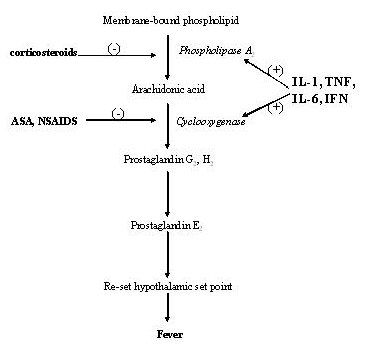![]() Reprinted from
www.antimicrobe.org
Reprinted from
www.antimicrobe.org
Fever - Antipyretic Therapy
Aspirin and the nonsteroidal anti-inflammatory drugs (NSAIDS) cause reduction in temperature by blocking cyclooxygenase involved in prostaglandin synthesis. See Figure 4. Three cyclooxygenase iso-enzymes have been identified. Cyclooxygenase-2 plays a more dominant role in the febrile and inflammatory response. Aspirin and older NSAIDS are non-selective cyclooxygenase-1 and 2 inhibitors. Newer selective C0x-2 inhibitors NSAIDS such as celecoxib (Celebrex, Searle), rofecoxib (Vioxx, Merck) and valdecoxib (Bextra, Pharmacia) were hoped to have less gastrointestinal and renal toxicities. Unfortunately these cyclooxygenase-2 inhibitors have been linked to increased myocardial infarction and both rofecoxib and valdecoxib have been withdrawn from the market. The oxidized metabolite of acetaminophen can block cyclooxygenase activity to account for some of its antipyretic actions. Corticosteroids can lower temperatures by blocking phospholipase A2 and reducing prostaglandin E2 synthesis. See Figure 4. This can be seen when dexamethasone is used as part of cancer chemotherapy or to reduce cerebral edema. Defervescence of fever by corticosteroids can mistakenly be interpreted as resolution of an infectious process.Most providers and patients mistakenly feel that a fever should be suppressed. It needs to be reinforced that fever is not detrimental even to extremes of 41º C. Within this range, temperatures do not cause thermal injury to the patient. It has been suggested that fever should be treated to reduce the metabolic demand in patients with acute cardiopulmonary illness or with central nervous system injury. Although the reasoning behind this suggestion is sound, data supporting this hypothesis is limited.
Fever is most often treated in an attempt to relieve symptoms. Antipyretic therapy, however, may exacerbate the cyclic chills and sweats that accompany a febrile illness and may in fact worsen the patient’s symptoms. The decision, therefore, to use antipyretics should be based more on patient symptoms than the height of the temperature. Many patients are not aware of their fever or minimally symptomatic from it and treating the fever may only make the patient feel worse. On the other hand, it is reasonable to treat a fever if the patient is uncomfortable from it or has associated myalgias or headache.
The major concerns with antipyretic use are toxicities of the drugs. Aspirin and NSAIDS can cause dyspepsia, gastric ulceration and gastrointestinal bleeding. Non-selective cyclooxygenase inhibitors can cause fluid and electrolyte disorders, acute renal failure and interstitial nephritis. NSAIDS are anti-platelet agents and may pose a bleeding risk for those undergoing surgery. Selective cyclooxygenase-2 inhibitors are reported to have reduced gastrointestinal and renal toxicity though have been linked to increased cardiac mortality. Acetaminophen can cause liver toxicity when used in cumulative doses of 4 g in a 24-hour period.
If it is elected to treat a fever with an antipyretic drug, it should be given “around the clock” and not “as needed”. This continuous suppression of the hypothalamic set point may help alleviate the sharp peaks and valleys of the daily fever elevations and reductions thus diminishing the associated chills and sweats. Aspirin, NSAIDS and acetaminophen are equally efficacious in reducing temperatures. Sponge bathing with tepid water may improve heat evaporation while avoiding peripheral vasoconstriction. Cooling blankets should be avoided. They may be very uncomfortable to the patient and counterproductive since the cold surface may cause shivering, increase metabolic rate and may actually raise core temperature.
Figure 4: Prostaglandin E2 Production
Prostaglandin E2 is synthesized from membrane bound phospholipid by phospholipase A2 and cyclooxygenase (COX). Corticosteroids inhibit phospholipase A2 while aspirin and non-steroidal anti-inflammatory drugs inhibit COX. Metabolites of acetaminophen can inhibit COX isoenzymes.
IL-1 = interleukin –1, TNF = tumor necrosis factor, IL-6 = interleukin-6, IFN = interferons, ASA = acetylsalicylic acid, NSAIDS = non-steroid anti-inflammatory drugs
Used with permission by Marcel Dekker Inc in Medical Management of Infectious Diseases, Ed C Grace, 2003.
